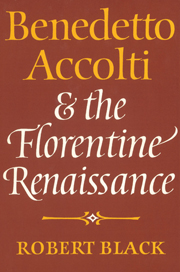Book contents
- Frontmatter
- Contents
- Dedication
- Preface
- Abbreviations
- 1 Arezzo in the early Renaissance
- 2 The Accolti family
- 3 Benedetto Accolti's early life and works
- 4 Accolti in Florence and Arezzo in the 1440s and early 1450s
- 5 Accolti's election as chancellor of Florence
- 6 The Florentine chancellorship
- 7 The Florentine chancery under Accolti
- 8 Accolti's Dialogus
- 9 Accolti's history of the first crusade and the Turkish menace
- 10 Accolti and Renaissance historiography
- Epilogue
- Appendix I Letters of Benedetto Accolti
- Appendix II Accolti's work as a palace official during his chancellorship
- Appendix III Pratica concerned with increasing Accolti's salary as chancellor
- Appendix IV Accolti and the incident of Ponzano, July–August 1463
- Select bibliography
- Index
1 - Arezzo in the early Renaissance
Published online by Cambridge University Press: 12 October 2009
- Frontmatter
- Contents
- Dedication
- Preface
- Abbreviations
- 1 Arezzo in the early Renaissance
- 2 The Accolti family
- 3 Benedetto Accolti's early life and works
- 4 Accolti in Florence and Arezzo in the 1440s and early 1450s
- 5 Accolti's election as chancellor of Florence
- 6 The Florentine chancellorship
- 7 The Florentine chancery under Accolti
- 8 Accolti's Dialogus
- 9 Accolti's history of the first crusade and the Turkish menace
- 10 Accolti and Renaissance historiography
- Epilogue
- Appendix I Letters of Benedetto Accolti
- Appendix II Accolti's work as a palace official during his chancellorship
- Appendix III Pratica concerned with increasing Accolti's salary as chancellor
- Appendix IV Accolti and the incident of Ponzano, July–August 1463
- Select bibliography
- Index
Summary
(i) Political and economic life
The history of Benedetto Accolti's native city, Arezzo, followed a characteristic pattern for a Tuscan city-state at the end of the middle ages: rapid expansion was succeeded by internal disruption, leading to loss of independence and prolonged civic decline. The climax of the Aretine commune's growth had been reached during the thirteenth century and was followed by almost a century of factional conflict and foreign war, culminating in the surrender of Arezzo to Florence in 1384. Florentine rule brought an end to overt political turmoil, but it also coincided with an economic depression from which Arezzo did not begin to recover until at least the sixteenth century.
For most of the thirteenth century Arezzo had prospered and its commune had grown stronger, but Arezzo's rise brought the commune into conflict with neighbouring towns, especially Florence and Siena, and in 1289 Arezzo was decisively defeated by Florence at the battle of Campaldino. This humiliation was followed by more than twenty years of dissension among Arezzo's leading families. Two factions, called the Verdi and the Secchi, emerged and eventually the Secchi prevailed, installing their leader, Guido Tarlati, bishop of Arezzo, as despot in 1312. The signoria of Guido Tarlati temporarily restored Arezzo's prestige: he built a new circuit of walls which greatly enlarged the city, restored Arezzo's dominions in the countryside, introduced a new silver and copper currency and replenished the city's treasury. He reached the highpoint of his career when he crowned Louis of Bavaria as emperor in Milan in 1327, but he died a few months later, bequeathing the signoria to his brother, Pier Saccone.
- Type
- Chapter
- Information
- Benedetto Accolti and the Florentine Renaissance , pp. 1 - 21Publisher: Cambridge University PressPrint publication year: 1985



